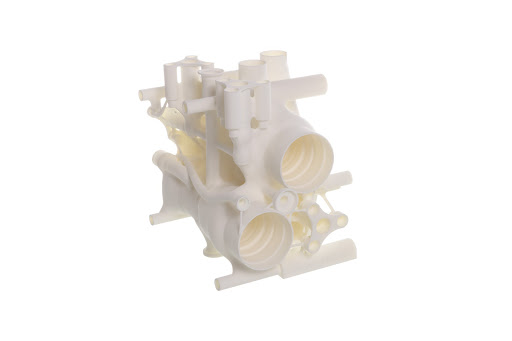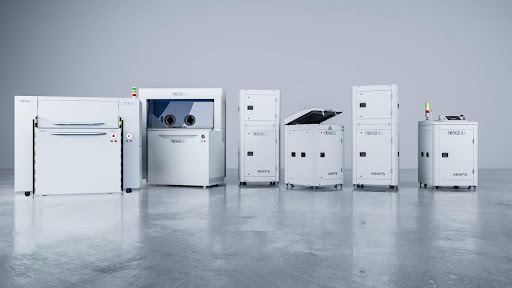- Markforged Onyx Filament Review & Alternatives [2024] - December 11, 2024
- 17 Best Professional 3D Printers: Commercial, Desktop, & Industrial [2024] - December 10, 2024
- Best 3D Printers (Industrial, Desktop, & More) [2024 Guide] - July 20, 2024
Selective Laser Sintering (SLS) 3D printing is a powder- based technology that creates complex geometries and components in engineering grade materials. This additive manufacturing process uses a high-powered laser to fuse small material particles to create a 3D object.
Unlike traditional manufacturing techniques, which often involve removing material from a larger block to create the desired shape, SLS 3D printing builds up the object layer by layer, resulting in less waste and more efficient use of materials. As this technology advances, many professionals across various industries are discovering its potential and the wide range of applications it offers.
This article will review how the SLS 3D printing process works, the advantages and challenges of the technology, and how this technology has been transforming the manufacturing world.
What is Selective Laser Sintering 3D Printing?
Selective laser sintering is the most common type of powder bed fusion 3D printing. SLS uses a laser to fuse small particles of various materials like plastic powders into a solid object. The process is known as sintering: providing accurate energy enough to diffuse a particle across the boundaries of another material.
SLS works by heating a bed of powder material with the laser to selectively melt parts of the powder. Once melted, the powder solidifies and forms a layer of the desired part shape. A new layer of powder is added above this melted layer and subsequently melted and fused to the layer below. This process is repeated until the entire part has been constructed.
Professionals often use SLS 3D printing technology for high-end prototypes, production parts, and functional components through various materials including polymers, metals, and ceramics.
The technology is widely used in the aerospace, automotive, and medical industries to produce parts that require tight tolerances or intricate details such as dental aligners, hearing aids, orthotics, and prosthetics.
SLS vs. SLM vs. MJF
SLS, selective laser melting (SLM), and multi-jet fusion (MJF) are all methods of Powder Bed Fusion (PBF) additive manufacturing. While all PBF 3D printing uses a high-energy power source for creating 3D objects, each of these technologies have distinct differences in their approach and the materials they use.
SLM uses high-power lasers as their heat source to melt particles (usually fine metallic powders) and then fuse them to create precise parts. Builders can use SLM to 3D print objects from metals and other materials that require high temperatures and pressures to fuse.
MJF uses a high-intensity light source to selectively fuse particles of a material–usually nylon or polymers–to create an object in one step. The process begins with a material layer that’s heated from below with a heater plate. The layers are then combined by jets of fusing and detailing agents.
How does SLS 3D printing work?
The selective laser sintering process starts with a computer-aided design (CAD) model of the object to be printed. This file is then sliced into hundreds of 2D layers and transferred to the printer’s controller. The powder bed inside the printer is then lowered by one layer of thickness, and a laser beam is used to selectively melt the thermoplastic powder particles where the object will appear.
After fusing, the bed advances lower for the next layer, and then the process is repeated until all layers have been printed and the part is completed. The powder acts as a support structure for overhanging parts since it’s not melted or sintered away.
Once this process is complete, the excess powder is removed and recycled for future use. The finished product can then be post-processed to enhance its surface finish and overall strength or rigidity.
Selective Laser Sintering Advantages
Selective laser sintering (SLS) offers several advantages over other 3D printing processes. It is an advanced process that can print an entire part in one piece without supporting structures. Here are some of the benefits that come with using SLS 3D printing:
High Speed and Throughput
Selective laser sintering (SLS) is a highly efficient technology capable of producing large volumes in short time frames. It has very fast print speeds compared to other 3D printing technologies and can produce complex parts quickly and accurately.
A perfect example is Nexa3D’s QLS series. The QLS 820 combines the best of SLS and HSS to deliver up to 4x the throughput of traditional laser sintering and other HSS polymer powder bed technologies.
The QLS 230 is the most affordable open platform SLS 3D printer for industrial use–as well as some of the fastest printing and cooling available on the market. It provides a 24 hour cycle speed using a single 30 Watt CO2 laser to produce prototypes with robust mechanical and thermal properties
The QLS 236 is another productivity powerhouse that uses a single 60 Watt CO2 laser to increase daily throughput without the need for a lengthy cooling period due to its smaller build chamber.
Learn more about Nexa3D SLS 3D printers.
Functional Part Quality
Parts produced using SLS 3D printing are strong and consistent. The surface of the printed parts is smooth, with excellent mechanical properties that makes them suitable for functional prototyping and end-use production.
Broad Materials Selection
SLS 3D printing allows for the use of various materials, from thermoplastics like ABS and nylon to metals like stainless steel and titanium. Its versatile material selection allows for the production of parts with a wide range of properties, from flexible to rigid.
Reduced Manufacturing Waste
Some SLS 3D printers, like Nexa3D’s QLS 230 and QLS 236, can support reduced manufacturing waste by using an open material platform to print reusable thermoplastic powders.
But, not all SLS 3D printers are created equal–and not all of them support sustainable 3D printing processes. Why?
- Some machines require new powder more frequently than others which can result in unused powder that needs to be disposed of, so it’s important to consider material requirements before making an investment. The way the powder is used also affects waste. With larger builds, more powder is needed, which can create more waste. Conversely, smaller builds require less powder and result in less waste. Smaller machines also print and cool much quicker, leading to higher throughputs and reduced print costs.
- Some machines are designed to only work with specific materials from a specific manufacturer. This means that it can be harder to find affordable materials or use materials that are more eco-friendly.
Overall, while SLS 3D printing can be more eco-friendly than other manufacturing methods, choosing the right machine that prioritizes sustainable manufacturing is a critical part of reducing material waste and printing costs.
Cost effective
SLS 3D printing can be more cost-effective than other 3D printing technologies and traditional manufacturing processes. Since the powder used in the process can be recycled and reused for future prints, professionals can reduce material waste and production costs.
Selective Laser Sintering Challenges
Selective laser sintering (SLS) 3D printing offers many advantages, but there are also some challenges associated with the technology. For example, the powders used in this technology are made up of very fine particles, so it’s critical to implement safety precautions when handling these materials.
Furthermore, which materials you can use are often limited in comparison to other 3D printing technologies, especially if the SLS 3D printer has a closed platform.
However, some SLS 3D printers can accommodate several materials. Nexa3D’s SLS 3D printers have open-source platforms that accommodate various materials. The QLS820 can 3D print PA12, PA11, Polypropylene, aluminum, glass, and fiber-filled materials. It also offers injection mold tolerances for full production capabilities, including high temp thermoplastics like PBT and PA6 materials.
The QLS236 also has incredible material flexibility: it has over 16 qualified materials including a range of Polyamides, PP, PBT, TPU–as well as the patented metal powders from headmade materials®. It also excels with recycled powders from HP and EOS.
Selective laser sintering applications

Engineering
The engineering industry is popular for using SLS 3D printing to produce functional prototypes, end-use parts, and highly complex components with excellent dimensional accuracy. It can also be used in 3D printed injection molding since it offers high resolution and intricate details.
Manufacturing
The manufacturing industry uses SLS 3D printing to produce parts with complex geometries, such as gears, without compromising on quality or cost. It can also help reduce lead times by eliminating the need for machining and traditional tooling processes.
A perfect example of SLS 3D printing in manufacturing is JawsTec, a manufacturing service provider that offers rapid prototyping to innovators, engineers, and entrepreneurs, producing parts for some of the most prominent brands on the planet, including Tesla, Apple, BMW, Ford, Delta, and SpaceX. The company specializes in 3D printing, CNC machining, and metal fabrication services.
JawsTec was frustrated by the wastage of end-of-life powder, which not only raised the company’s operating overhead and impacted profit, but also represented a significant environmental issue for a company committed to sustainable manufacturing.
To address this challenge, JawsTec quickly deployed four of Nexa3D’s QLS 230 machines and a Nexa3D QLS 820 machine, completing setup and training in less than a month. The QLS series printers helped JawsTec eliminate sintering powder waste altogether while significantly lowering the waste ratio of sintering powders used, which in turn enhanced company sustainability and streamlined costs.
These SLS 3D printers also helped JawsTec optimize the usage rates of recycled powder. With the enhanced packing density rate of the QLS series printers, the company was able to utilize 100% of their powders, which was not possible with their older systems that were running a 50% new powder refresh rate.
As a result, JawsTec was able to reduce the wastage of end-of-life powder and raise SLS manufacturing output by 50%, due to the platform’s shorter printing cycles. The QLS series printers also provided remote maintenance, which slashed JawsTec’s downtime from days to just hours.
Production
SLS 3D printing is also used in the production sector for rapid prototyping and producing highly accurate parts in small batches. This process speeds up the design cycle and helps to reduce product development costs, allowing companies to bring products to market faster.
Automotive manufacturers often use SLS 3D printing to produce customized car body parts. It’s especially beneficial for companies who want to produce high-end custom cars in relatively low volume. SLS 3D printing enables designers to create parts with intricate details that would otherwise be impossible to produce traditionally–and reduces overall production costs.
Choose the best selective laser sintering 3D printer

Selective laser sintering (SLS) is a great option for users who want to produce functional parts and accurate prototypes with complex geometries. However, before investing in an SLS 3D printer, it’s important to consider certain needs and ensure that the printer meets all requirements.
Nexa3D’s SLS 3D printers offer unprecedented production capabilities designed with automation and scalability in mind. The ultra-fast printing means you can produce parts at a fraction of the time and cost–while also providing superior part accuracy with a great surface finish.
We know 3D printing is an investment, so we’d love to take the time to speak with you, answer any questions, and determine how any printer from the QLS series can revolutionize your production process.
Gain a deeper understanding of SLS 3D printing with our SLS 3D Printing Production Readiness Guide.
